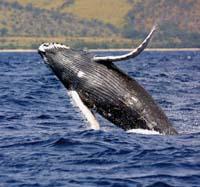A sound world

The density of air and water are very different, so the senses work differently in one or the other. Or more directly, the transmission of light, sound or smells that are the basis of the senses is different in one and the other medium.
Light waves rarely advance in water, and some spectrum colors are quickly lost. As the depth is gaining the color blue, and then… the darkness, in very few meters, in many seas. Consequently, vision is very limited under water.
Something similar happens with smell. Being the slower diffusion of molecules in water, smell is less useful than in air. Thus, those two senses that terrestrial animals, and especially mammals, have so developed for communication and perception of the environment are quite limited under water.
In an unvisual and olfactory environment, sound can be very important. In addition, the sound is transmitted perfectly in the water, and faster is the transmission speed: in the water the sound is transmitted 4.7 times faster than in the air (1.600 m/s). Therefore, the use of sound can be of great value in the water.
These may be the reasons why the use of sound in cetaceans develops so clearly. It is used to communicate with each other, but also to know the environment through the echolocation.

Not all cetaceans use sound equally. They are divided into two groups: Dental cetaceans are cetaceans with teeth --dolphins, orcas, sperm whales, mazopas, crows, etc.- that use sound for echolocation and communication. Mysticetus cetaceans have burrs instead of teeth and are generally known as whales -- whales, chickpeas and cereals. Their sounds are more mysterious. The most widespread belief is that they use sound only for communication, although it is not clear what they communicate, but there are also those who think they have capacity for echolocation.
View slope
The ecolloquiation consists of emitting and receiving echo of sound waves. And in that are skilful cetaceans with teeth. The brain analyzes how the waves received have changed from those emitted and how long it takes to return them. This way, they can know what surrounds them and where they are. You can see it through sounds, so to speak. And not only do they see it, but they often hunt with an ear.
To create sounds for ecolloquiation, dentists do not have a vocal cord like ours. Instead, they form lips in the larynx near the nostril. They are called phonic lips and produce sound by passing the air.
However, the sounds of ecolloquiation have not occurred and have been removed directly into the water. In fact, the sound produced by phonic lips is directed inward, reflected in the skull and passed through a fat structure on the forehead. This structure, called melon, is made up of different density fats. Thus, it behaves like an acoustic lens that helps send the sound like a narrow beam.
The main receiver of the echoes is the lower gag, from where the sound is transmitted to the ears through a fatty tissue that transports the sound very well. They can also hear the sound coming from the sides thanks to other fats around them.

The sounds they use for echolocation are high-frequency clicks in the field of ultrasound. These clicks are repeated very quickly. Dolphins, for example, may be able to make between 800 and 1,200 clicks in a second and, of course, process the echoes that come back.
Dentists also use sound to communicate. In this case, the frequency range they use can be very wide, and in addition to the clicks they use in the echolocation, they perform txistus and different sounds. For example, sperm whales make relatively low frequency needles (about 50Hz).
Knowing what they communicate is not easy. According to researchers, sounds can help the group be united. When they go in group it is usual to go to txistu without stopping. And they have seen how the group around responds to the sounds produced by the orcas away from the group with similar sounds and how, then, the lost target a group at full speed.
In addition, each group can have its own sound dialect. And, moreover, it is possible that, at least in some species, the identifying sign of each individual, their sound or their melody.
From there, to know what else they communicate, interpretations are often needed. And that is going into great waters. However, researchers are sure that these txistus and sounds can have different meanings.
Whale Songs

Mysticetus cetaceans prefer low-frequency sound needles or stripes to clicks and txistus. And also those who sound good, the blue whale and the sky can be the most sound animals in the world: They can reach 184-188 decibels --a pneumatic hammer generates 100 dB-. But it can happen that, despite their sonority, we barely hear or nothing, since those strokes are very low frequency, sometimes from the area of the infrasonides. The blue whale manufactures 10-40Hz needles and 16-40Hz cerques. A person with very good hearing usually hear up to 20 Hz at most.
Whale sounds can fill the entire ocean. In fact, such serious and sound sounds are perfect for long distances and whale leaves can travel thousands of miles. It should be borne in mind that, unlike cetaceans with teeth that usually move in groups, where communication occurs at small distances, whales often walk alone and make huge distances. Therefore, from the point of view of communication, it may be important to have such voices for whales.
Whales have no phonic lips or vocal cords. It seems that the larynx and cranial breasts have to do with the sound creation mechanism, but it is not clear what it is. And it is not the only unsolved mystery about whale sounds. Most researchers believe that whales do not have echolocation capacity, although there are few who argue against it. Nor is it clear what they use sound for.
Since Xibart's famous songs are made only by males, it can be thought that it has a sexual function, a way of courting... But they also sing outside the reproductive era, and when the males around listen to another male, they often approach and continue swimming together. What are counted?
Other sounds are also used both male and female. Sometimes group hunting and making sounds. And it seems that their prey knows what these noises mean, that they tremble when they are heard.
In small groups, on the contrary, a rorcual predominates, which seems to lead the dialogue while others respond.

There are several hypotheses to explain the functions that whale sounds can play: maintaining distances between them, identifying species and individuals, transmitting information in specific situations (food, courtship, alarm...), maintaining social organization, as well as knowing the topographic characteristics or finding prey.
We may not know much about cetacean communication, but it seems that sound is important to them. However, the noise in the oceans is growing and is not due to the proliferation of whales. Marine noise pollution increases year after year. It is not clear to what extent cetaceans can be affected, but the landings of some cetaceans have been related to the use of military sonars and, in a study conducted in Vancouver, they discover that orcas have altered the frequency of their sounds and have increased their amplitude as maritime traffic increases.
The viewer may have damage similar to that caused by excessive light, to which excessive noise must be heard. The higher the noise pollution, the lower the world of cetaceans.


Buletina
Bidali zure helbide elektronikoa eta jaso asteroko buletina zure sarrera-ontzian










